Search Forum
240 Head Swap on 300
|
SHE RUNS!!
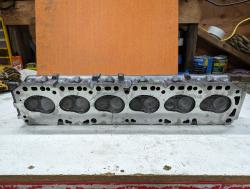 1968 F100 240 head. Picked it up for cheap and had the local shop check it over and smooth the mating surfaces. Also added screw in rocker studs and hardened seats. I went over it with some grinding bits to remove casting marks and slag from 1968 but no appreciable "head work". I didn't have the cash and I didn't want to mess anything up doing a port/polish myself. 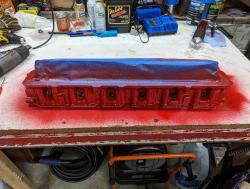 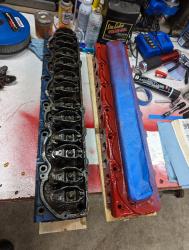  Headgasket is Fel-Pro 1024. I followed all torque guidance to 85 ft-lbs in 3 stages. I did not apply any sealant. The surfaces were cleaned thoroughly and I vacuumed out the cylinders. 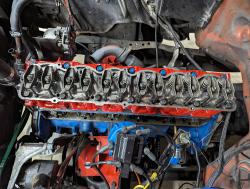 Setting up the rocker arms: The method I used to get valve lash might be controversial but upon 1st startup, it seemed to work like a charm. Disassemble lifters (1 at a time! Be sure to reinstall them into the same hole they came out of!) and dump out the oil. Make sure to reinstall the pieces EXACTLY in the opposite order you disassembled them. Install the pushrods (ideally into the same place they came out of), rockers and nuts finger tight. Then: It doesn't matter where the engine is sitting in the 4 cycles. Just tighten the rocker nut until the pushrod has no play between the lifter and the rocker. Do this on all valves where applicable. Some will be "hard up". Next, manually rotate the engine 90 degrees and go through the valves again, tightening all that have play. NOTE: this is not referring to twisting the rocker side to side, this is only referring to up and down movement in the pushrod. Keep doing this process until none require adjustment. Make sure you've gone at least 2 full rotations of the crankshaft. I went 4. IT IS IMPORTANT THAT THE LIFTERS HAVE BEEN EMPTIED OF OIL BEFORE you: tighten each rocker nut 3/4 of a turn to load the lifters. 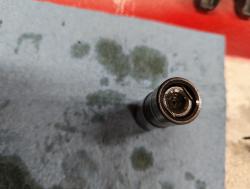  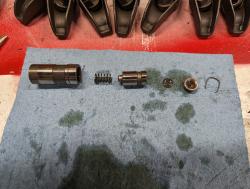 I finished the install, leaving the valve cover off. (and the pushrod cover ON!) Pulled the fuel pump fuse, hooked up the battery and cranked the engine over (spark plugs still removed!) until the lifters were primed with oil and I could verify that everything was working as it should. I cranked it over multiple times, waited for the starter to cool between each cycle, watching oil pressure via my AutoMeter gauge. I forgot to talk about the EFI exhaust manifolds: the Dorman units that were removed were broken (maybe 20k miles on them) which explains my suspected exhaust leak at the head. So I went a scrappin' and found 2 sets off an 87 and 89. I picked the best set and sent to the machine shop to have them resurfaced. They took off .008". The manifolds were cleaned and painted with 2000 deg header paint. 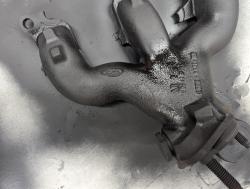 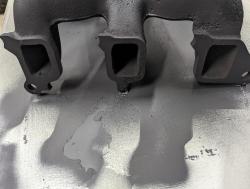 Filling the coolant system was a little bit of a hassle. I made a mess, adding coolant while trying to run at 1500 RPM for 15 minutes. But nothing broke and I kept a very close eye on engine temp and felt the hoses to ensure coolant was flowing. (meanwhile, all the paint and moisture and stuff was cooking off the hot parts) I used a Motorcraft 192F thermostat. Conventional 10W-30 with zinc additive. Changed the oil after the 15 minutes of run-in. New FL-1A filter and Rotella T6 10W-30. Engine Assembly lube went on every surface where metal was touching. Rocker bolts and half-round washers, head studs, pushrod ends, valve tops where rockers meet. I used Mr Gasket #260 for the intake/exhaust. It was no fun getting the exhaust manifolds installed with that big Offenhauser in the way. So I had to cut the exhaust pipe behind the transmission crossmember in order to move the Y-pipe and that gave me tons of extra room. Then I dropped a thick washer perfectly down into the rear Y-pipe....sheesh. It shot out when I fired up the motor! I set the timing to 7 deg BTDC to fail conservatively until I can see what amount of timing the engine will handle on 87 pump gas, I think my timing was a little too advanced for a while and it damaged the top of my pistons slightly. (Looked like very small raindrops in the sand and more brown than I expected) Cylinders looked good. The engine fired up perfectly in less than 3 seconds of cranking over. No uncharacteristic valve clatter whatsoever.  There are certainly some ponies left on the table with expensive, time consuming head work but I mostly just wanted to do the project for the Frankenstein coolness factor and the hope for a little more power. This truck brings me so much joy, it's almost crazy but I know all you guys get it. 
1985 F150 4x4 SB 300 I6: Comp 268 cam, '68 240 head, Offy DP, FI manifolds, Holley Sniper 2300, DUI street/strip distributor, BW T-18, Tuff Country 4" suspension lift, Yukon Offroad hubs + front and rear Duragrip LSD 3.73 ratio, 33-12.5/15s
Oklahoma boy livin in Washington State. Retired submarine MMNCM (Nuclear Machinist's Mate, Master Chief) |
|
Administrator
|
Congratulations!!! That initial firing is one of the best feelings in the world.
 And your process seems like it worked out very well, even the dropped washer. Well done! And your decision to start with a bit less initial lead is a good one. You can always add a bit more if you find that it can take it. (There's a process to do that, as explained on our page at Documentation/Electrical/Ignition and the Instructions tab followed by the Crane Cams Instructions tab.) Have you driven it yet? How does it feel vs the "old" engine? I'd think the smaller head would up the compression ratio enough to be felt.
Gary, AKA "Gary fellow": Profile
Dad's: '81 F150 Ranger XLT 4x4: Down for restomod: Full-roller "stroked 351M" w/Trick Flow heads & intake, EEC-V SEFI/E4OD/3.50 gears w/Kevlar clutches
|
|
Well, Gary....It runs great. My expectations weren't high for performance on this and I have the timing held back so much that it isn't yet a "no brainer" power addition. Also, I cut the exhaust right before the cat, so it's wildly loud and I'm not putting my foot into it until I get another muffler on at least. Less noise would also make it easier to tune.
I enjoyed the project and having a story to tell is part of the fun. I'm happy to have the opportunity to find some hidden problems (the cracked exhaust manifold) and possibly put a larger diameter exhaust on. My setup had a 2.25" (it was actually smaller than that) pipe coming out of the muffler. I don't want it crazy loud but it'll flow better with 2.5 or 3" downstream of the cat. My Gear Vendors unit will be delivered this Friday!! So now I've got to decide what other work I want to do while I have the transfer case removed. Then find a vendor to modify my driveshaft or make me a new one. If you have a suggestion on the driveshaft I'm all ears. Thanks! My post was a little chaotic but I hope it's good enough to help someone out in the future.
1985 F150 4x4 SB 300 I6: Comp 268 cam, '68 240 head, Offy DP, FI manifolds, Holley Sniper 2300, DUI street/strip distributor, BW T-18, Tuff Country 4" suspension lift, Yukon Offroad hubs + front and rear Duragrip LSD 3.73 ratio, 33-12.5/15s
Oklahoma boy livin in Washington State. Retired submarine MMNCM (Nuclear Machinist's Mate, Master Chief) |
|
Administrator
|
Be careful with retarded ignition timing.
Your engine is going to be running hot and 300's are known to warp heads and manifolds.
Jim,
Lil'Red is a '87 F250 HD, 4.10's, 1356 4x4, Zf-5, 3G, PMGR, Saginaw PS, desmogged with a Holley 80508 and Performer intake. Too much other stuff to mention. |
|
Thanks for the info! I didn't know or even consider that. I did notice the coolant temp about 10F higher than before. I guess I was overly worried about pre-detonation. I'm not confident that I would be able to detect it, even with a super quiet muffler.
1985 F150 4x4 SB 300 I6: Comp 268 cam, '68 240 head, Offy DP, FI manifolds, Holley Sniper 2300, DUI street/strip distributor, BW T-18, Tuff Country 4" suspension lift, Yukon Offroad hubs + front and rear Duragrip LSD 3.73 ratio, 33-12.5/15s
Oklahoma boy livin in Washington State. Retired submarine MMNCM (Nuclear Machinist's Mate, Master Chief) |
Bullnose Enthusiasts Forum
›
Projects
|
1 view|%1 views
| Edit this page |

